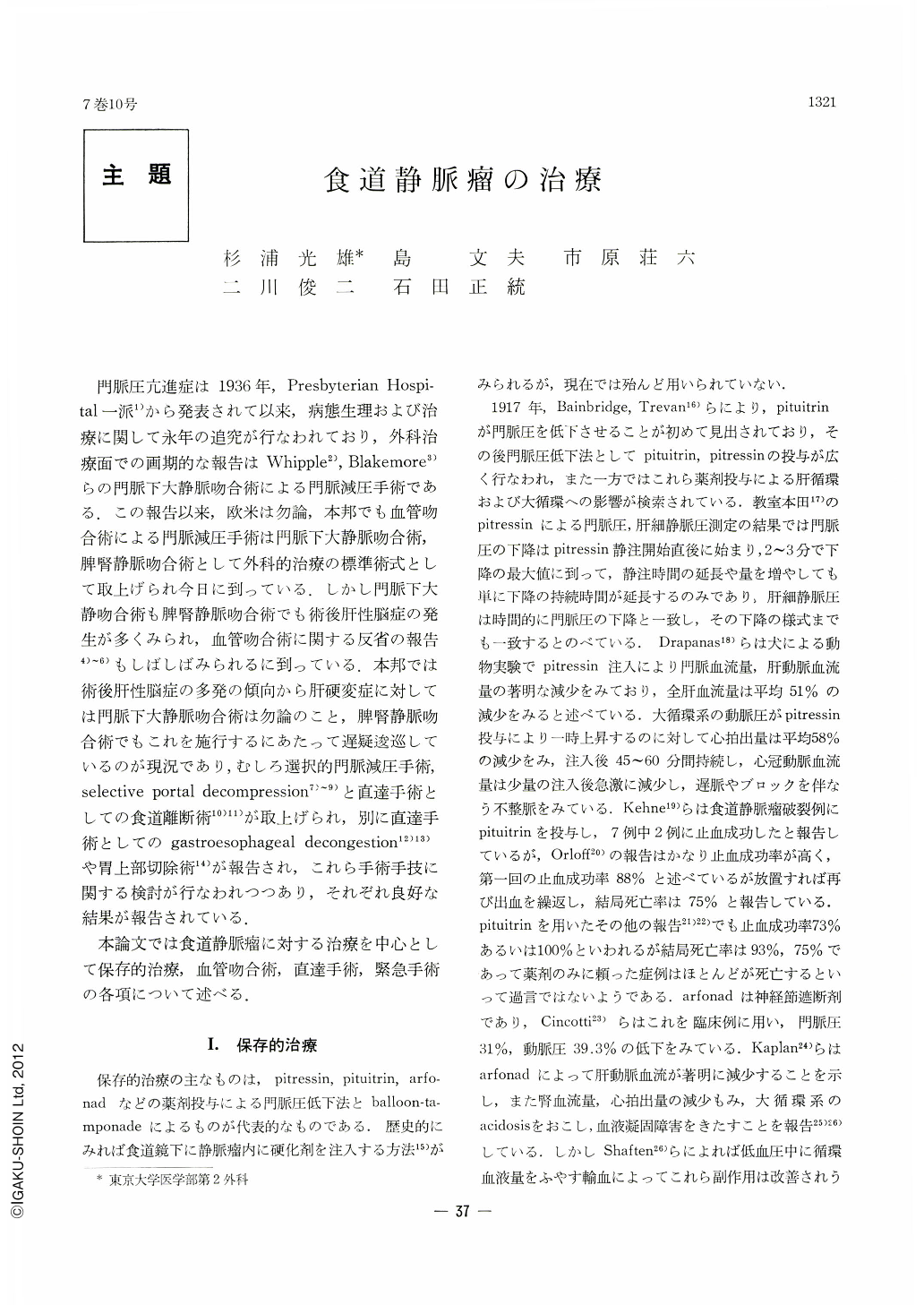Japanese
English
- 有料閲覧
- Abstract 文献概要
- 1ページ目 Look Inside
門脈圧亢進症は1936年,Presbyterian Hospital一派1)から発表されて以来,病態生理および治療に関して永年の追究が行なわれており,外科治療面での画期的な報告はWhipple2),Blakemore3)らの門脈下大静脈吻合術による門脈減圧手術である.この報告以来,欧米は勿論,本邦でも血管吻合術による門脈減圧手術は門脈下大静脈吻合術,脾腎静脈吻合術として外科的治療の標準術式として取上げられ今日に到っている.しかし門脈下大静脈吻合術も脾腎静脈吻合術でも術後肝性脳症の発生が多くみられ,血管吻合術に関する反省の報告4)~6)もしばしばみられるに到っている.本邦では術後肝性脳症の多発の傾向から肝硬変症に対しては門脈下大静脈吻合術は勿論のこと,脾腎静脈吻合術でもこれを施行するにあたって遅疑逡巡しているのが現況であり,むしろ選択的門脈減圧手術,selective portal decompression7)~9)と直達手術としての食道離断術10)11)が取上げられ,別に直達手術としてのgastroesophageal decongestion12)13)や胃上部切除術14)が報告され,これら手術手技に関する検討が行なわれつつあり,それぞれ良好な結果が報告されている.
本論文では食道静脈瘤に対する治療を中心として保存的治療,血管吻合術,直達手術,緊急手術の各項について述べる.
In the past the objectives of surgical treatment for portal hypertension included esophageal varices, hypersplenism and ascites, but in recent years medical management of ascites has been so improved that the varix of the esophagus now represents the main aim of surgery for portal hypertension. Conservative treatment of sudden bleeding due to ruptured esophageal varices does not always bring about good results. Prognosis would be better if medical management of ruptured varices be considered as a temporary measure to tide over an emergency to be rescued later by surgical intervention.
Surgical management of esophageal varices is twofold: first, various shunt operations as a procedure to lower portal pressure, and, secondly, direct surgical approaches to the varices themselves. For vascular shunts selective operation for portal decompression is mostly employed in our country. With the advancement of surgical procedures operative mortality and re-bleeding have greatly reduced, often attended with reports of lessened or disappeared esophageal varices.
Ligature of esophageal varices hitherto employed as a direct emergency operation still remains of temporary effect. On the other hand, transthoracic esophageal transection (esophageal transection with paraesophago-gastric devascularization) employed by us at the Second Department of Surgery, Faculty of Medicine, Tokyo University, has been tried consecutively with good results in more than 100 patients for the past 8 years. The rate of operative death was one percent for elective operation. Even in emergency operation only two patients in very hopeless condition succumbed to surgical intervention (operative mortality for this type of operation was 13 percent). Disappearance or reduction of esophageal varices was seen in the great majority of patients. Transthoracic esophageal transection has a great merit, not only as an emergency operation but also as a prophylactic surgical procedure, because the risk for the patient is minimal. We are of the opinion that its indication is fairly extensive.

Copyright © 1972, Igaku-Shoin Ltd. All rights reserved.


